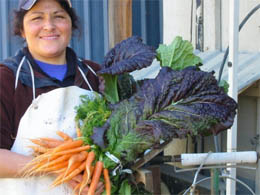Research, Education & Farming
- By Judith Redmond
- Reading Time: 4 mins.
By Judith Redmond of Full Belly Farm, courtesy of Capay Valley Farm Shop
Years ago, when I was studying at the University of California, I noticed that there was research being done on “organic” agriculture with results that proved it to be not viable. Upon closer examination, it turned out that the researchers had compared plots of carrots, one treated with chemical fertilizers, pesticides and herbicides, and the other abandoned with no care and no attention. The sad abandoned plot was the “organic” comparison.
At that same time, innovative farmers up and down California were learning and relearning agricultural practices that worked with Nature’s cycles and Nature’s wisdom to grow beautiful organic carrots without chemicals. These farmers were giving their crops a plentitude of attention but found that Cooperative Extension and University researchers were uniformly unfriendly.
Much has changed since then, and I do not tell the story to cast a negative light upon the University or upon Cooperative Extension. In fact, I apologize to any scientists or extension agents who might now be reading and feel slighted. The story is here because I wish to suggest to readers that our public research and extension institutions are in dire need of public investment and support.
Agriculture faces multiple interlocking challenges across the globe. Poverty and political instability make it difficult for farmers to feed their communities in some countries. Water pollution and land erosion deplete the resources we must have to grow food. A changing climate threatens to disrupt the harvest more every year. And our populations are growing, with chronic hunger and malnutrition on the rise.
Want farm-fresh fruit?
We've got you covered.
A report just released by Food and Water Watch (www.foodandwaterwatch.org/reports/public-research-private-gain/) details a growing dependence on corporate funding at American public agricultural universities. Although studies consistently indicate a very high return on investments in agricultural research, public investment has slowed during the past few decades. It peaked in 1994 and has declined 20% since then. In contrast, by 2010, corporate funding for agricultural research provided nearly a quarter of all the funds and often leveraged the public resources to the purpose of the private funders. This industry funding steers research towards the goals of industry, just as the carrot study that I observed as a graduate student helped to discourage the growth of organic agriculture. The chemical input suppliers did not expect organic farmers to provide a market for their products and wanted to nip the growing movement in the bud.
But don’t misunderstand! I believe that public-private partnerships at research institutions are critical to the ability of researchers to conduct socially relevant projects. Many farms and other businesses provide copious time and resources to University researchers in order to insert on-the-ground reality into the research agenda. However, if public investment in agricultural research continues to decline, food and farming issues will not be addressed in innovative ways. This is not a time to abandon the University infrastructure that delivered breakthroughs like improved seeds, new plant varieties, a greater understanding of soil conservation and much more. Without public funding, the mission of agricultural universities will be distorted and fashioned to favor the industry sponsors.
 Image courtesy of Full Belly Farm, Guinda CA
Image courtesy of Full Belly Farm, Guinda CA
Thoughts like these seem worlds apart from our daily effort to stay on top of spring’s demands at the farm. This year’s spring is quite unlike that of last year when it rained and rained and rained. This year it’s a hot spring, which means both spring and summer crops are growing fast. Harvest has to start early in the morning so that the chard, kale, collards, and lettuce are in the cooler before the morning’s cool has turned to the afternoon’s heat.
The practical result of the hot spring is that your boxes are full of greens, hopefully, a welcome sight on your tables. Green salad a few nights, carrot on the side another couple of meals, a potato main dish, roasted broccoli perhaps? And greens every which way. With that kind of thinking these boxes full of greens will be gone in a twinkling. Your plates, when you sit down to meals, will mostly be green vegetables, right? These spring vegetables fresh from the fields are a great source of nutrients and minerals with many benefits to your health.
But I wouldn’t take it all for granted. Nature isn’t fragile, but she also isn’t gentle. Here’s what Wendell Berry said about her: “Whether we and our politicians know it or not, Nature is a party to all our deals and decisions, and she has more votes, a longer memory, and a sterner sense of justice than we do.”


